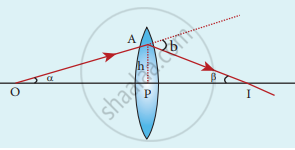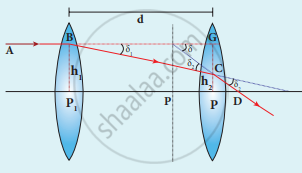Advertisements
Advertisements
Question
Derive the equation for effective focal length for lenses in out of contact.
Long Answer
Solution
- Let O be a point object on the principal axis of a lens. OA is the incident ray on the lens at a point A at a height h above the optical centre. The ray is deviated through an angle δ and forms the image I on the principle axis.
- The incident and refracted rays subtend the angles. ∠ AOP = α and ∠ AIP = β with the principle axis respectively.

- In the triangle ∆ OAI, the angle of deviation δ can be δ = α + β
If the height h is small as compared to PO and PI the angles α, β and δ are also small then,
α ≈ α = `"PA"/"PO"; and beta ≈ tan beta = "PA"/"PI"`
Then, `δ = "PA"/"PO" + "PA"/"PI"`
Here, PA = h, PO = - u and PI = v
`δ = "h"/(-"u") + "h"/"v" = "h"(1/(- "u") + 1/"v")`
After rearranging,
`δ = "h"(1/"v" - 1/"u") = "h"/"f"`
`δ = "h"/"f"` - For a parallel ray that falls on the arrangement, the two lenses produce deviations δ1 and δ2 respectively and The net deviation δ is
δ = δ1 + δ2
δ1 = `"h"_1/"f"_1`
δ2 = `"h"_2/"f"_2`
δ = `"h"_1/"f"` .....(1)
`"h"_1/"f" = "h"_1/"f"_1 + "h"_2/"f"_2`
Lens in out of contact
From the geometry,
h2 – h1 = P2G – P1G = CG
h2 – h1 = BG tan δ1 ≈ BG δ1
h2 – h1 = `("dh"_1)/"f"_1`
h2 = h1 + `("dh"_1)/"f"_1` .....(2)
`"h"_1/"f" = "h"_1/"f"_1 + "h"_2/"f"_2 + ("h"_1"d")/("f"_1"f"_2)`
On further simplification,
`1/"f" = 1/"f"_1 + 1/"f"_2 + "d"/("f"_1"f"_2)`
The above equation could be used to find the equivalent focal length.
To find the position of the equivalent lens, we can further write from the geometry.
PP2 = EG = `"GC"/(tan δ)`
PP2 = EG = `("h"_1 - "h"_2)/(tan δ) = ("h"_1 - "h"_2)/δ`
From equation (1) and (2)
h2 – h1 = d`"h"_1/"f"_1` and
δ = `"h"_1/"f"`
PP2 = `["d" "f"/"f"_1]`
The position of the equivalent single lens from the second lens. Its position from the first lens.
PP1 = d – `["d" "f"/"f"_1]`;
PP1 = d`[1 – "f"/"f"_1]`
shaalaa.com
Thin Lens
Is there an error in this question or solution?
